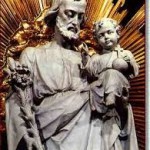“Idol vs. Icon”
“Idol vs. Icon”
William Dyrness, in his book “Visual Faith” explores the concept of spiritual and religious art. He discusses the historical transitions of art within Christianity due to theology and iconoclasm, especially after the Protestant Reformation; as well as the contemporary resurgence of religious art in its variety of forms.
I decided to take the concept of art and religion to my students in our World Religions class. I asked them to discuss the difference between an idol and religious art. They came to the conclusion that an idol has no meaning outside of itself therefore things like money or a superstar would be considered an idol whereas an icon or even statue that points to something outside of itself is not an idol. Dyrness expresses that religious art expresses abstract concepts such as the crucifixion of Christ or the devotion of Mary to her Son Jesus. These are “pointers” to a spiritual story which can stir the emotions of an individual. I pushed my students to consider Hindu vigrahas and Christian saints. Are these idols? In this case it depends on the worshiper and his/her approach to the object. Hindus and Christians devote themselves to certain objects of devotion depending on the role the object represents. For example a St. Christopher necklace may be worn for safety and protection and a necklace with a Ganesha image represents the concept of “remover of obstacles” and assistance in new ventures. An idol seems to have no meaning that is outside of itself whereas art and icons tend to be “pointers” or representatives of concepts outside of themselves.
As Dyrness explains iconoclasts destroyed Christian images, icons and art. This part of Christian history is evident today in Protestant churches where typically only a cross might be displayed. However, in Roman Catholic Churches one can see elaborate art, statues, icons and images in stained glass windows. So where does one draw the line between idols and icons? When does an icon or statue become an idol? By being too focused on not worshipping idols has Protestant Christianity turned its back on art that might be helpful in making abstract concepts attractive to the mind of a worshiper? By focusing on words in place of visual art has faith become more vague and less clear?

Leave a Reply
You must be logged in to post a comment.